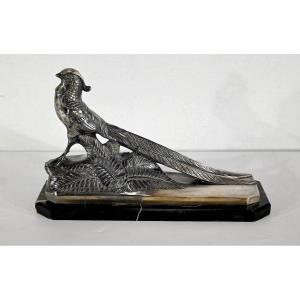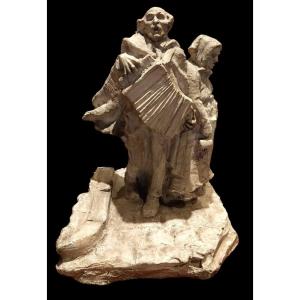- Tail newly fixed, spearhead somewhat bent, isolated rubbed areas where the zinc shimmers through. Overall in excellent condition for its age.
- In the name of freedom -
Without having received a commission for it, August Kiss began modeling the artistic idea for his masterpiece in clay in 1837. By 1839 he had found the final form, the presentation of which aroused such enthusiasm that an appeal for funds, supported by Frederick William IV, provided the means to have the sculpture cast in a monumental form by Christoph Heinrich Fischer in 1842 and placed prominently on the left side of the staircase of the Altes Museum in 1843. Shortly before, Kiss had executed the group in marble for King Ludwig I of Bavaria. In 1865, he created another version in marble, which is now in the Antwerp Art Museum.
A full-size electroformed cast, made by the Geiss foundry in Berlin in 1851, won the Grand Prize at the London World's Fair that year and was exhibited at the Crystal Palace in New York in 1853, making August Kiss an internationally sought-after artist.
The bare-breasted Amazon is attacked by a mighty panther, which bites into the horse's neck and inflicts deep wounds with its claws. The predator is possessed by the hunting instinct, while the horse, its eyes wide with terror, tries to rear up to shake off the aggressor, to which it would have succumbed completely if the Amazon had not fearlessly fought off the attacker with her spear. Even gripped by the fury of an uncontainable determination, she strikes a powerful death blow with her hair flowing and defeats the beast.
The entire group of sculptures proclaims the physical and physical forces at work. The panther's tail is curled up with energy, while the horse's tail is erect. Even the Amazon's big toe is splayed out, testifying to her almost superhuman tension. From every angle, the sculpture reveals a different aspect of the battle for life and death, with a level of detail and precision that makes the large-scale zinc casting before our eyes a technical masterpiece.
The Fighting Amazon is a transposition of St. George fighting the dragon into the iconography of antiquity. The fact that St. George fighting on horseback was also an important theme for Kiss is illustrated by his monumental St. George, created in 1855 for the castle courtyard, which today stands in the Nikolai quarter. The transfer to ancient iconography makes the Christian metaphysical of good against evil much more political. Accordingly, the Amazon wears a Phrygian cap, which has become a universal symbol of freedom since the French Revolution, on the assumption that it was the headgear of freed slaves. The attack of the black panther, which - in contrast to the lion or tiger - stands for the dark forces, is therefore also an attack on the liberal Prussian state, in which the palace as the monarch's residence and the museum as a civic temple form a synthesis. Kiss's work was therefore financed by a fund-raising campaign by the citizens of Berlin, supported by Frederick William IV.
With its expressiveness overcoming the dignity of Christian Daniel Rauch's classicism, The Fighting Amazon had such a stylistic impact that Albert Wolff's Lion Fighter on Horseback was erected on the opposite side of the staircase in 1861-also made possible by donations from citizens. The sculptural pair was copied in bronze in 1929 for the staircase of the Philadelphia Museum of Art, where it also flanks the entrance to the museum.
About the artist
August Kiss, the son of an ironworks inspector, was familiar with the art of metal casting from the very beginning. After an apprenticeship at the ironworks in Paprotzan and at the model workshop of the Royal Iron Foundry in Gliwice, he worked from 1822 at the Royal Iron Foundry in Berlin, which met the increasing demand for artistic iron casting that arose with the Napoleonic Wars. Even the finest jewelry was made of iron, whose black patina gave the metal an elegant appearance
Parallel to his work for the foundry, Kiss studied at the Academy of Fine Arts and, from 1825, became a student and then a collaborator of the most important bronze sculptor of his time and co-founder of the Berlin School of Sculpture, Christian Daniel Rauch, whose major work was the monumental equestrian statue of Frederick the Great erected on Unter den Linden in 1851. He also worked for Christian Friedrich Tieck, another protagonist of the Berlin School. Kiss played a key role in the creation of the horses for the cast iron Dioscuri, Castor and Pollux as horse tamers (1826-28), for the roof of the Altes Museum (1825-30), which was still under construction. This led to a friendship with the architect of the Altes Museum, Karl Friedrich Schinkel, with whom Kiss collaborated on several occasions. He received the state commission for the now destroyed tympanum of Schinkel's Nikolaikirche in Potsdam (1833-35). The fact that the state awarded the commission to an artist who was barely thirty years old testifies to the high esteem in which Kiss was already held. His real artistic breakthrough, however, came with the Fighting Amazon, which was placed on the left side of the staircase of the Altes Museum in 1843. With this work, he finally broke free from the quiet dignity of Rauch's classicism and found his own dramatic style, which shaped Berlin's Neo-Baroque. The work, which was financed by donations from citizens, made Kiss an internationally sought-after artist and earned him the reputation of being the best artist of his time to depict horses.
In the wake of the Amazon, he created monumental equestrian statues of Frederick the Great (1841, Breslau), Frederick William III (1844, Königsberg / 1847, Breslau) and St. George (1855, Nikolaiviertel Berlin). He also created the statues of Wilhelm Beuth (1854-61, Schinkelplatz) and Hans Karl von Winterfeldt (1861, Zietenplatz) for the Berlin Palace District.
Kiss was so successful with his art during his lifetime that he was able to donate 300,000 marks to the National Gallery for the purchase of new works.











































 Le Magazine de PROANTIC
Le Magazine de PROANTIC TRÉSORS Magazine
TRÉSORS Magazine Rivista Artiquariato
Rivista Artiquariato